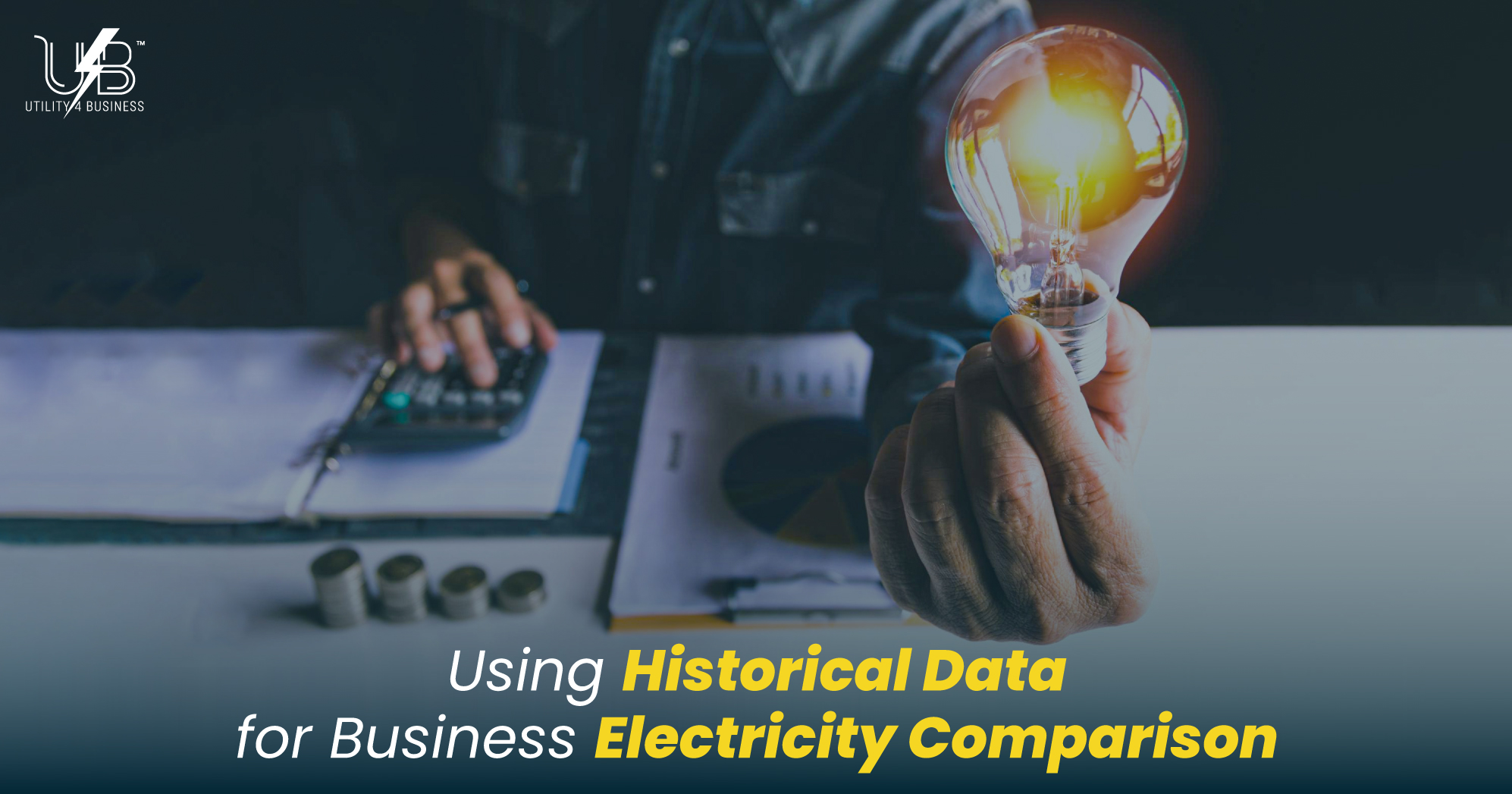Using Historical Data for Business Electricity Comparison
Cut Business Energy Costs with Past Data

A good energy deal does not start with a price on a banner. It starts with the numbers already on a company’s bills. Historical data shows how a site actually uses power across months, seasons, and hours. With that insight, a business electricity comparison becomes a true like-for-like check rather than a guess based on a single p/kWh headline. The right contract lines up with real usage, not an average that hides peaks, quiet periods, and charges that sit outside the unit rate. This article explains how to gather past data, clean it, read the load profile, and use it to compare business electricity options with confidence. It also shows how Utility4Business supports this process for UK businesses that want clear savings without the noise.
What historical data means for a business
Historical data means at least a full year of bills with kWh per billing period, standing charges, and the unit rates in place at the time. Two years give a stronger view across seasons. Sites with half-hourly meters hold interval data at 30-minute steps. That pattern exposes baseload at night, morning ramps, and daytime peaks. Time-of-use splits, such as day, night, and evening, also matter. These splits show whether a contract with cheaper off-peak hours will cut costs in practice or only on paper. Meter type, contract dates, and any site changes belong with the data because they affect usage. A new chiller, longer opening hours, or added EV charging can shift the whole profile.
Why historical data beats headline p/kWh
A low unit price can look strong until the bill lands and shows high standing charges or a poor match to the usage shape. Historical data puts every offer through the same test. It applies the quoted rates to the actual kWh used at the times they were used. It includes the standing charge across the real number of days. It reflects the site’s peaks and troughs rather than an average that hides them. In short, a business energy comparison that uses past bills models total cost, not only price per unit. That is the only fair way to compare business electricity prices.
Where to find and export the data
Past invoices provide monthly kWh, standing charges, and rates. Supplier portals often offer CSV exports for faster analysis. Smart meters improve accuracy and make interval data easier to access. When portals fall short, data can be requested from the supplier. Utility4Business guides businesses through data requests and checks that exports include the fields needed to run a robust business electricity price comparison.
Prepare and clean the dataset
Data needs a tidy home before any business electricity comparison. Missing months must be filled or flagged. Estimated reads should be replaced by actual reads when possible. Outliers need context. A week of shutdown, a new oven, or a trial of longer hours changes usage and should sit in a notes column. A simple spreadsheet can hold one row per billing period with columns for start date, end date, kWh, unit rate or rates, standing charge per day, total standing charge, meter type, and notes. Where interval data exists, a second sheet can hold 30-minute kWh values with dates and times. Clean data speeds the next step: reading the load profile.
Read the load profile
Every site carries a baseload that stays on even at night. Peaks then build around open hours, production cycles, or events. A clean profile shows where the energy goes and when. One helpful measure is load factor. Take the average demand over a period and divide it by the peak demand in that period. A higher load factor means usage sits closer to the peak across the day, which often supports contracts that reward steadier demand. A lower load factor means sharp peaks, which can push up costs if a contract penalises peak times. Charts help. A 24-hour curve reveals patterns at a glance. A weekday versus weekend view can uncover chances to move processes into cheaper periods. When a site can shift non-critical loads, time-of-use offers become more attractive in a business electricity comparison.
Align the profile to the right tariff shape
The market offers fixed-rate contracts, variable products, and time-of-use options. The best fit depends on the profile, not only on appetite for risk. Sites with a strong off-peak share can benefit from a day/night split. Sites with a tight baseload and small peaks may do well on a simple fixed rate. Standing charges matter just as much. A low-use site that spreads usage across many days can still pay more if the standing charge runs high. A business energy comparison should test both rate structure and standing charge against the same baseline year. That test reveals how much each element pulls on the total.
Build a total cost model
A fair model takes each offer and applies it to the historical kWh in the same periods. For monthly bills, multiply the unit rate by the kWh used in that month and add the standing charge per day times the days in that month. For time-of-use deals, apply the correct rate to each kWh in the matching window. Half-hourly data makes this precise because it shows when the site used energy across the day. The model should also test what happens if usage rises or falls by a modest amount. A ten to twenty per cent swing helps check how sensitive each offer is to changes in volume. This approach moves the focus from a single rate to the whole bill. It also makes the comparison business electricity exercise honest, because it replays the past year under each offer’s rules.
Choose a contract length that fits the plan
One-year terms give flexibility if the site expects a change. Two- or three-year terms can smooth costs and secure rates for longer. The right choice depends on the stability of usage and the need for budget certainty. Historical data helps here as well. If usage and opening hours have been steady across a year or two, a longer term can lock in the benefit found in the business electricity price comparison. If the site plans a major change, such as new equipment or an extra shift, a shorter term can keep options open until the new pattern settles.
Handle multi-site portfolios with care
Portfolios often mix meter types and usage shapes. A head office may run a steady baseload, while a warehouse peaks in the morning and a retail unit peaks in the afternoon. A sound business electricity comparison for a portfolio models each site on its own data, then rolls the results into a weighted view. Staggered renewals can reduce risk. Blending different contract shapes can also help when sites behave very differently. Utility4Business supports portfolio analysis and presents one view that still respects differences between sites.
Practical workflow without the jargon
A strong workflow starts with collecting at least twelve months of bills and, where possible, interval data. The next step cleans the numbers and adds notes about any events that changed usage. Then the analysis sets a baseline bill for the past year to prove the model matches what actually happened. With the baseline in place, the model applies each offer to the same twelve months. The review then checks totals, unit costs, and standing charge impact, followed by a light stress test on volume. The final step weighs savings against contract length, terms, and any service commitments needed on-site. This flow keeps the compare business electricity prices task simple, clear, and fair.
Conclusion
Historical data turns a business electricity comparison into a measured decision. The model shows what each offer would have cost over the past year. It reveals whether a time-of-use option fits the usage shape or whether a flat rate serves better. It quantifies the impact of standing charges. It highlights small operational changes that unlock extra savings. Most of all, it replaces guesswork with a repeatable method that anyone can check. Utility4Business helps UK companies use their own data to make a smarter business energy comparison. The team collects the past bills, builds a clean baseline, and applies each offer to the same usage. The analysis shows clear totals, not vague averages.
Find This Article Helpful? Share It Now!
At Utility4Business, we offer top-notch customer support and business utility solutions for businesses across the UK. Consider sharing this article and helping others discover how our expertise can add value to their business success.

Read Our Latest Posts
Explore our latest blog posts and learn how Utility4Business can support your business growth with tailored utility solutions and services. Stay ahead of the curve with the latest information from industry experts and take advantage of our user-friendly comparison services to find the best business deals.


Get Connected
At Utility4Business, our team of experts can help you figure out the highest-value business utility deals that will help your business grow over time.

